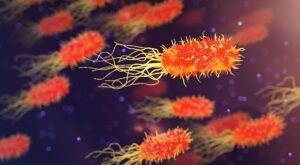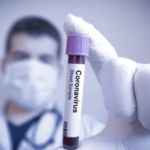The latest data from humans, animals, and food show that a large proportion of Salmonella bacteria are multidrug-resistant.
In humans, resistance to ciprofloxacin is common, particularly in certain types of Salmonella, and resistance to high concentrations of ciprofloxacin increased overall from 1.7% (2016) to 4.6% (2018). For Campylobacter, 16 out of 19 countries report very high or extremely high percentages of ciprofloxacin resistance.
High proportions of resistance to ciprofloxacin are also reported in Salmonella and E. coli bacteria from poultry. Ciprofloxacin is a fluoroquinolone, a class of antimicrobials categorised as critically important for use in humans. If fluoroquinolones lose their effectiveness, the impact on human health could be significant.
However, combined resistance – simultaneous resistance to two critically important antimicrobials – to fluoroquinolones and third generation cephalosporines in Salmonella and to fluoroquinolones and macrolides in Campylobacter remains low.
For 2018, the report lists sporadic cases of human Salmonella infection with resistance to carbapenems, a last-line antimicrobial.
Mike Catchpole, ECDC’s chief scientist, said:
The most effective way to prevent the spread of carbapenem-resistant strains is to continue screening and responding promptly to positive detections. ECDC is working with EU Member States and with EFSA in a One Health approach to enhance the early detection and monitoring, in an effort to fight the persisting threat of antimicrobial-resistant zoonotic infections.
The report also includes key outcome indicators that help the EU Member States assess their progress in reducing the use of antimicrobials and combatting antimicrobial resistance.
In food-producing animals, the summary indicator of susceptibility to all antimicrobials has increased in E. coli in just under 25% of Member States (6) over the period 2014-2018. This is a positive development as it means that in these countries, in case of need, treatments with antimicrobials would have a higher chance to be successful. Decreasing trends in the occurrence of extended-spectrum β-lactamase (ESBL) or AmpC-producing E. coli have been observed in about 40% of Member States (11) during 2015-2018. This is also important because ESBL-AmpC-producing E. coli is responsible for serious infections in humans.
Regarding last-line antimicrobials, resistance to colistin was not common in Salmonella and E. coli, and carbapenemase-producing E. coli were not detected in broilers, turkeys and broiler meat.
In humans, the decline in resistance to ampicillin and to tetracyclines in Salmonella Typhimurium in many countries is another encouraging trend observed in 2013-2018.
The EU Summary Report is an annual ECDC and EFSA publication that looks at the status of antimicrobial resistance in bacteria affecting humans, animals, and food.
More information
Communicable disease threats report, 1-7 March 2020, week 10







Leave a Reply